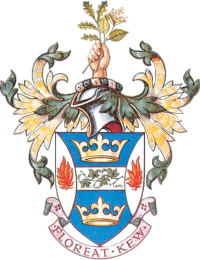Henry Robert Cocker
1906 - 1995
Cocker, H.R. (1936), Some impressions of Lake Maggiore and the Borromean Islands, The Journal of The Kew Guild 5: 544–550 (with a page of plates).
Cocker, H.R. (1945), Horticulture in India, The Journal of The Kew Guild 6: 376–383 (with three plates).
Cocker, H.R. (1949), Villa Taranto Gardens, Pallanza, Italy, Journal of The Kew Guild 6: 670–676 (with six plates).
Goodall, Nancy-Mary (1990), Cocker’s Italian Triumph, The Garden 115: 407–411.
Goodall, Nancy-Mary (1991), Henry Cocker and some contemporaries, Hortus 5: 20–31.
The son of a doctor, Henry Cocker was born in Palmers Green, London on 3 July 1906. He became infatuated with gardening and on leaving school he worked in a number of nurseries, including Carter Page at London Wall and Perry’s Hardy Plant Farm at Enfield.
Henry entered Kew as a student gardener in December 1928, passing out in 1933. Whilst here, Henry was awarded the Kew Certificate with a distinction in systematic botany, ecology and genetics, and his training incorporated a 15-month exchange to the Hanbury Garden at La Mortola in Italy to gain experience in sub-tropical horticulture.
Following the end of his time at Kew, Henry returned to Italy and worked as a gardener at Ospedaletti, where he caught the attention of Captain Neil McEacharn. A wealthy man, McEacharn had an estate - Villa Taranto - at Lake Maggiore, and wanted a Kew-trained, Italian-speaking gardener to help him achieve his goal of creating his dream garden. Henry was handed the task and oversaw the creation of the garden, which McEacharn later bequeathed to the nation, and among his achievements was the first flowering in Europe of Davidia involucrata and Emmenopterys henryi.
During World War II, Henry enlisted in the RAF, serving in Libya, Egypt, South Africa, India and Ceylon (Sri Lanka), and observing the native flora wherever he went. After the war, he returned to Villa Taranto, which had become greatly run down. Undeterred, and accompanied by a horde of staff, Henry set about restoring and expanding the gardens to make them one of the great gardens of Europe. He remained there until 1960, earning a reputation as a garden designer.
Henry worked as a garden consultant for many celebrities and members of the European nobility, including Prince Borromeo, the Rockefeller Foundation, Peggy Guggenheim, Carlo Ponti and Sofia Loren, and HRH Princess Aspasia of Greece. He was often called upon to give lectures and judge at horticultural shows, including Chelsea., and for some years was Technical Advisor to the Lombardy Horticultural Society in Milan.
In 1950 Henry was awarded the Associate of Honour by the Royal Horticultural Society. He wrote a number of books and made many contributions to horticultural and other publications – including the three contributions to The Journal of The Kew Guild cited below.
He was a life member of The Kew Guild and the archives at Kew contain several materials relating to him, including correspondence, photographs, working papers, lecture notes, and autobiographical notes.
Henry died in Venezia, Italy on 3 January 1995.
